汽车发展史_(英文
- 格式:ppt
- 大小:3.42 MB
- 文档页数:16
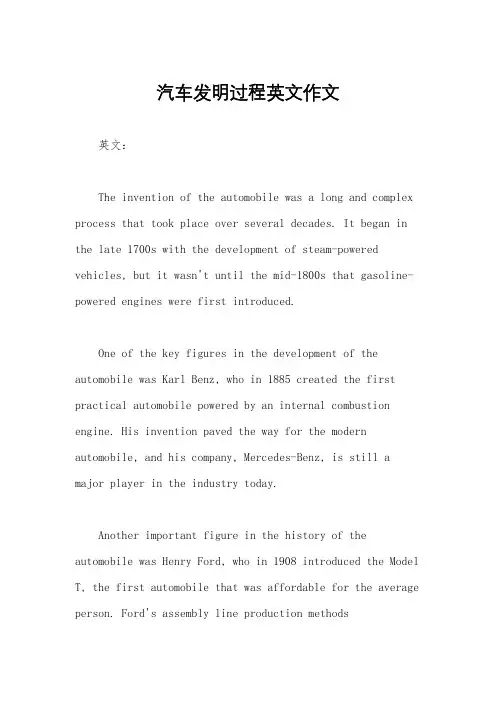
汽车发明过程英文作文英文:The invention of the automobile was a long and complex process that took place over several decades. It began in the late 1700s with the development of steam-powered vehicles, but it wasn't until the mid-1800s that gasoline-powered engines were first introduced.One of the key figures in the development of the automobile was Karl Benz, who in 1885 created the first practical automobile powered by an internal combustion engine. His invention paved the way for the modern automobile, and his company, Mercedes-Benz, is still a major player in the industry today.Another important figure in the history of the automobile was Henry Ford, who in 1908 introduced the Model T, the first automobile that was affordable for the average person. Ford's assembly line production methodsrevolutionized the manufacturing process and made automobiles accessible to millions of people.Over the years, automobiles have continued to evolve and improve. Today, we have electric and hybrid cars, self-driving cars, and cars that can communicate with one another. The automobile has become an essential part of modern life, and it's hard to imagine a world without them.中文:汽车的发明是一个漫长而复杂的过程,历时几十年。
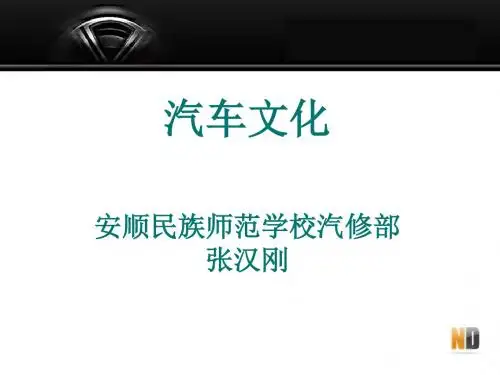
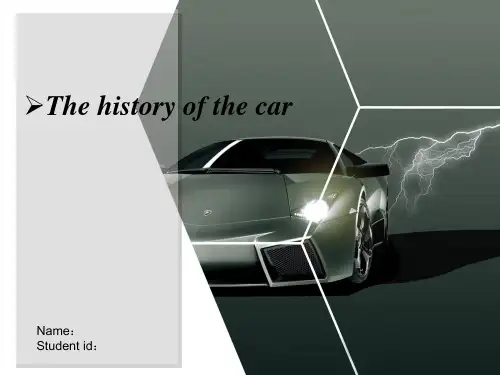
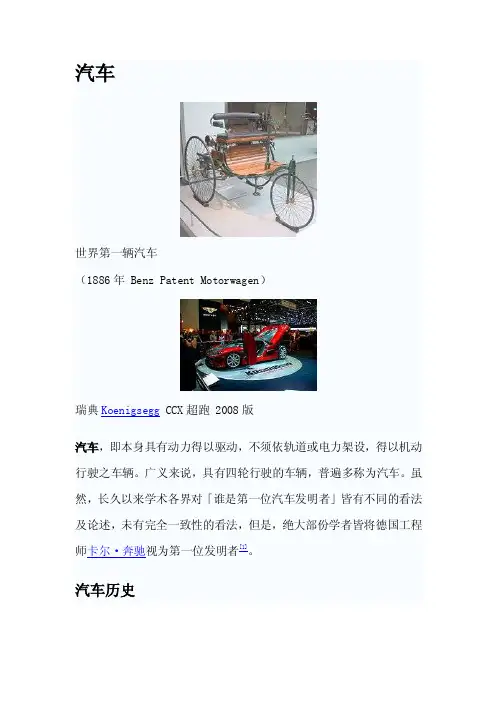
汽车世界第一辆汽车(1886年 Benz Patent Motorwagen)瑞典Koenigsegg CCX超跑 2008版汽车,即本身具有动力得以驱动,不须依轨道或电力架设,得以机动行驶之车辆。
广义来说,具有四轮行驶的车辆,普遍多称为汽车。
虽然,长久以来学术各界对「谁是第一位汽车发明者」皆有不同的看法及论述,未有完全一致性的看法,但是,绝大部份学者皆将德国工程师卡尔·奔驰视为第一位发明者[1]。
汽车历史蒸汽车∙1888年,法国自行车商人埃米尔·罗杰斯(Emile Roger)获得朋驰的许可,开始生产商用汽车。
安全性环境保护主条目:环境保护2008每千人拥有汽车比率 601+ 501-600 301-500 151-300 101-150 61-100 41-60 21-40 11-20 0-10定义与分类各国法律依汽车的使用方式、大小、功能,所付予的定义与分类:日本定义∙使用内燃机行使的车辆,超过三轮以上,或二轮但是排气量大于125mL分类∙乘用车:以搭载人员为主的车o普通自动车:总重5吨以下,载重3吨以下,载人10人以下o普通机车:排气量125mL以上400mL以下两轮车o小型机车:排气量400mL以上两轮车∙载运车:载货空间大于载人空间的车或载运10人以上的车o中型自动车:总重5吨以上11吨以下,载重3吨以上6吨以下,载人10人以上29人以下o大型自动车:总重11吨以,载重6.5吨以上,载人30人以上∙特殊作业车:不属于以上两者,且有运输之外的主要用途o小型特殊自动车:有运输外用途最高速15km以下全长4.7m以下、全幅1.7m以下、全高2.8m以下o大型特殊自动车:有运输外用途不符上述小型标准者中华人民共和国分类∙小型、微型非营运载客汽车∙摩托车∙拖拉机∙其他机动车基本构造说明:词汇内容选用多数汽车公司所拥有的科技词汇为对象,不计少数汽车公司的科技词汇。
词汇名称与中译名称皆以台湾汽车工业或学术机构常用的美式英语名称为对象,不使用日式英语词汇。
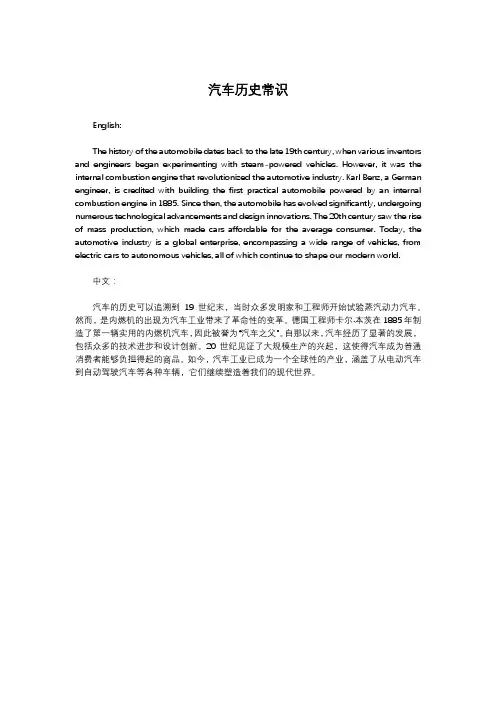
汽车历史常识English:The history of the automobile dates back to the late 19th century, when various inventors and engineers began experimenting with steam-powered vehicles. However, it was the internal combustion engine that revolutionized the automotive industry. Karl Benz, a German engineer, is credited with building the first practical automobile powered by an internal combustion engine in 1885. Since then, the automobile has evolved significantly, undergoing numerous technological advancements and design innovations. The 20th century saw the rise of mass production, which made cars affordable for the average consumer. Today, the automotive industry is a global enterprise, encompassing a wide range of vehicles, from electric cars to autonomous vehicles, all of which continue to shape our modern world.中文:汽车的历史可以追溯到19世纪末,当时众多发明家和工程师开始试验蒸汽动力汽车。
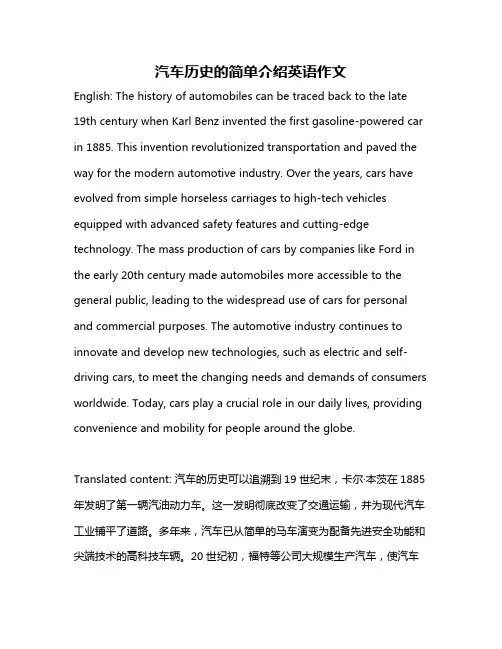
汽车历史的简单介绍英语作文English: The history of automobiles can be traced back to the late19th century when Karl Benz invented the first gasoline-powered car in 1885. This invention revolutionized transportation and paved the way for the modern automotive industry. Over the years, cars have evolved from simple horseless carriages to high-tech vehicles equipped with advanced safety features and cutting-edge technology. The mass production of cars by companies like Ford in the early 20th century made automobiles more accessible to the general public, leading to the widespread use of cars for personal and commercial purposes. The automotive industry continues to innovate and develop new technologies, such as electric and self-driving cars, to meet the changing needs and demands of consumers worldwide. Today, cars play a crucial role in our daily lives, providing convenience and mobility for people around the globe.Translated content: 汽车的历史可以追溯到19世纪末,卡尔·本茨在1885年发明了第一辆汽油动力车。
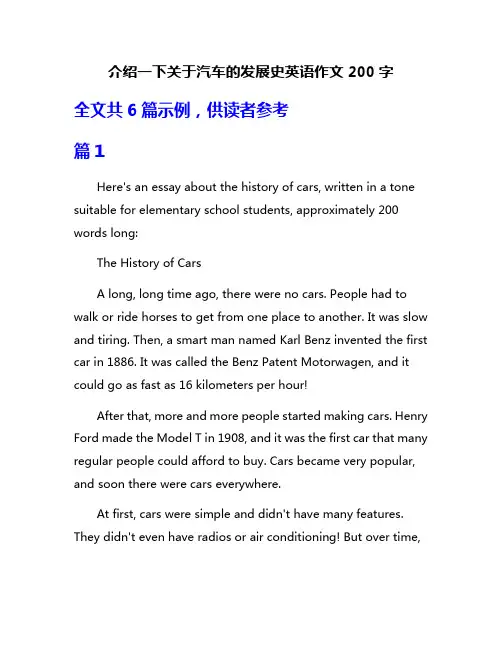
介绍一下关于汽车的发展史英语作文200字全文共6篇示例,供读者参考篇1Here's an essay about the history of cars, written in a tone suitable for elementary school students, approximately 200 words long:The History of CarsA long, long time ago, there were no cars. People had to walk or ride horses to get from one place to another. It was slow and tiring. Then, a smart man named Karl Benz invented the first car in 1886. It was called the Benz Patent Motorwagen, and it could go as fast as 16 kilometers per hour!After that, more and more people started making cars. Henry Ford made the Model T in 1908, and it was the first car that many regular people could afford to buy. Cars became very popular, and soon there were cars everywhere.At first, cars were simple and didn't have many features. They didn't even have radios or air conditioning! But over time,engineers kept making cars better and better. They added radios, air conditioning, seatbelts, and all kinds of other cool things.Nowadays, cars are much faster, safer, and more comfortable than the very first ones. Some cars can even drive themselves! Who knows what kinds of amazing cars we'll have in the future? One thing is for sure – cars have come a long way since the Benz Patent Motorwagen!篇2The Amazing Story of Cars!Long ago, there were no cars at all. Can you imagine that? People had to walk or ride horses everywhere they went. That must have been really hard and taken a lot of time!Then in the 1800s, some really smart inventors started thinking about making something faster and easier than horses. They wanted to make a machine that could move all by itself without any animals pulling it. Crazy idea, right?One of the first people to make a vehicle like this was a German guy named Gottlieb Daimler in 1886. His vehicle was powered by a gasoline engine and is considered one of the first true automobiles. Around the same time, another Germaninventor named Karl Benz made a similar kind of gas-powered vehicle. These were like super early, basic versions of the cars we have today!In 1908, Henry Ford started a company to make a car that regular people could afford to buy. It was called the Model T. Ford made the process of building cars much faster by using assembly lines in his factories. This made cars way cheaper so more people could get one. Over 15 million Model Ts were made!As time went on, car companies kept making cars better and adding cool new features. They got faster engines, better tires, radios, heaters, and all sorts of other fun stuff. Buying a new car with the latest tech became really popular.Today, we have some super high-tech cars with computer screens, backup cameras, and even driving assistance that can help steer for you. Some cars are electric and don't need gasoline at all. The possibilities for what future cars will be like are endless!Cars have come a incredibly long way since the old school horseless carriages. What was once just a dream of replacing horse travel became a hugely successful industry that changedthe entire world. Pretty neat, right? Who knows what awesome new car inventions are still to come!篇3The History of CarsCars are so cool! They can take us all over town and even on long trips. But cars haven't been around forever. A long time ago, people just had to walk everywhere or ride horses. That must have been really tiring!The very first car was invented in 1886 by two German men named Gottlieb Daimler and Wilhelm Maybach. Their car was called the Motorwagen and it could go almost 10 miles per hour! Can you imagine walking that fast? I can't!In 1908, Henry Ford started making a car called the Model T. It was affordable so more people could buy cars. His factory could make a new Model T car every 24 seconds! That's super fast.Over the years, cars got bigger, faster, and fancier. Now we have cars that can park themselves, cars that run on electricity instead of gasoline, and even self-driving cars! Who knows what amazing cars we'll have in the future?Cars have come a really long way from that first little Motorwagen. I'm glad we don't have to walk or ride horses everywhere anymore. Thanks to cars, we can go practically anywhere we want!篇4The History of CarsA long time ago, people had to walk or ride horses to get places. It was very slow! Then, people invented a new machine called the car. Cars could move much faster than horses.The first real car was made in 1886 by a German man named Karl Benz. His car was called the Benz Patent Motorwagen. It had a gasoline engine and three wheels. It could go about 10 miles per hour.In 1908, a company called Ford started making cars for normal people to buy. Before that, only rich people could afford cars. The Ford Model T was cheap and simple. Over 15 million Model Ts were made!In the early 1900s, cars became more popular. People started racing cars for fun. Some cars could now go over 100 miles perhour! New companies like General Motors and Chrysler started making cars too.After World War 2, cars got better and better. They had radios, heaters, and other cool things. Companies made different types like trucks, vans, and SUVs. Today, over 1 billion cars drive on roads around the world! Cars changed everything.篇5The History of CarsCars are super cool! They let us travel really far and fast. But cars haven't been around forever. A long, long time ago there were no cars at all! Can you imagine that?The very first car was invented way back in 1886. It was made by two German inventors named Gottlieb Daimler and Karl Benz. Their early cars looked really weird and went pretty slow compared to today's cars. They only went about 10 miles per hour!As time went on, cars got better and better. In 1908, a company called Ford started mass producing a simple, affordable car called the Model T. This helped make carsavailable for regular people, not just the super rich. By the 1920s, over 15 million Model Ts had been made!In the 1950s and 60s, cars became sleeker and more stylish. Tail fins and chrome became popular designs. Seatbelts were added to keep people safer too. Nowadays, cars are computers on wheels with backup cameras, navigation systems, and hybrid or electric engines that are better for the environment.Who knows what cars will be like in the future? Maybe they'll fly or drive themselves! One thing is for sure - cars have come a really long way since their humble beginnings over 130 years ago. Isn't that just amazing?篇6The History of CarsA long, long time ago, there were no cars! Can you imagine that? People had to walk everywhere or ride horses and buggies. It was very slow.Then in the 1800s, some very smart inventors started experimenting with engines that could power vehicles. The first gasoline-powered automobile was invented in 1885 by Karl Benzin Germany. It had three wheels and could go about 10 miles per hour. Not very fast!In 1908, Henry Ford started mass producing a simple, affordable car called the Model T. This made cars available to regular people, not just the rich. By the 1920s, there were over 20 million Model Ts on the road!As time went on, cars got faster, bigger, and fancier. They got radios, heaters, and air conditioning to make riding more enjoyable. Tail fins and chrome became popular designs in the 1950s. Cars looked really cool and futuristic!Today's cars are packed with high-tech features like backup cameras, navigation systems, and hybrid engines. Electric cars are becoming more common too. Who knows what cars will be like in the future? One thing is for sure - humans sure have come a long way from those first three-wheeled automobiles!。
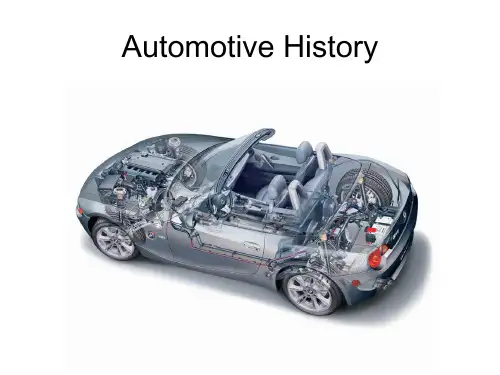
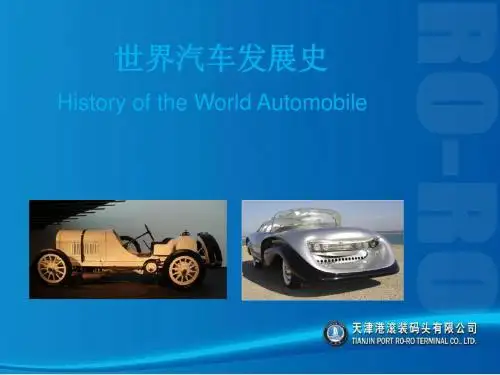

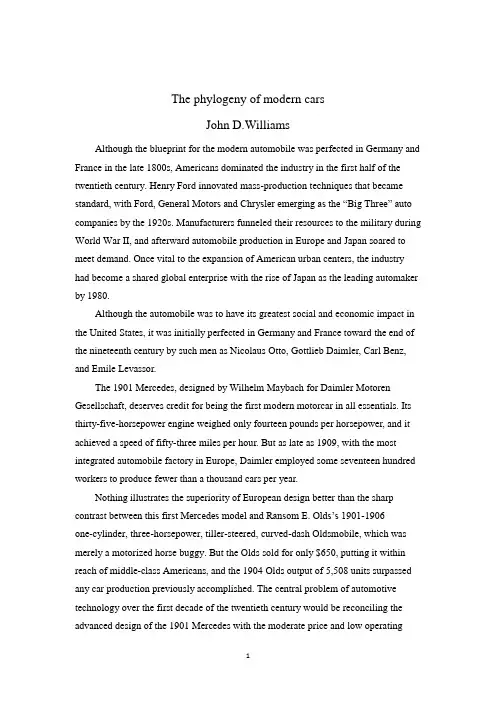
The phylogeny of modern carsJohn D.WilliamsAlthough the blueprint for the modern automobile was perfected in Germany and France in the late 1800s, Americans dominated the industry in the first half of the twentieth century. Henry Ford innovated mass-production techniques that became standard, with Ford, General Motors and Chrysler emerging as the “Big Three” auto companies by the 1920s. Manufacturers funneled their resources to the military during World War II, and afterward automobile production in Europe and Japan soared to meet demand. Once vital to the expansion of American urban centers, the industry had become a shared global enterprise with the rise of Japan as the leading automaker by 1980.Although the automobile was to have its greatest social and economic impact in the United States, it was initially perfected in Germany and France toward the end of the nineteenth century by such men as Nicolaus Otto, Gottlieb Daimler, Carl Benz, and Emile Levassor.The 1901 Mercedes, designed by Wilhelm Maybach for Daimler Motoren Gesellschaft, deserves credit for being the first modern motorcar in all essentials. Its thirty-five-horsepower engine weighed only fourteen pounds per horsepower, and it achieved a speed of fifty-three miles per hour. But as late as 1909, with the most integrated automobile factory in Europe, Daimler employed some seventeen hundred workers to produce fewer than a thousand cars per year.Nothing illustrates the superiority of European design better than the sharp contrast between th is first Mercedes model and Ransom E. Olds’s 1901-1906one-cylinder, three-horsepower, tiller-steered, curved-dash Oldsmobile, which was merely a motorized horse buggy. But the Olds sold for only $650, putting it within reach of middle-class Americans, and the 1904 Olds output of 5,508 units surpassed any car production previously accomplished. The central problem of automotive technology over the first decade of the twentieth century would be reconciling the advanced design of the 1901 Mercedes with the moderate price and low operatingexpenses of the Olds. This would be overwhelmingly an American achievement.Bicycle mechanics J. Frank and Charles E. Duryea of Springfield, Massachusetts, had designed the first successful American gasoline automobile in 1893, then won the first American automobile race in 1895, and went on to make the first sale of an American-made gasoline car the next year. Thirty American manufacturers produced 2,500 motor vehicles in 1899, and some 485 companies entered the business in the next decade. In 1908 Henry Ford introduced theModel T and William C. Durant founded General Motors.The new firms operated in an unprecedented seller’s market for an expensive consumer goods item. With its vast land area and a hinterland of scattered and isolated settlements, the United States had a far greater need for automotive transportation than the nations of Europe. Great demand was ensured, too, by a significantly higher per capita income and more equitable income distribution than in European countries.Given the American manufacturing tradition, it was also inevitable that cars would be produced in larger volume at lower prices than in Europe. The absence of tariff barriers between the states encouraged sales over a wide geographic area. Cheap raw materials and a chronic shortage of skilled labor early encouraged the mechanization of industrial processes in the United States. This in turn required the standardization of products and resulted in the volume production of such commodities as firearms, sewing machines, bicycles, and many other items. In 1913, the United States produced some 485,000 of the world total of 606,124 motor vehicles.The Ford Motor Company greatly outpaced its competitors in reconcilingstate-of-the-art design with moderate price. Cycle and Automobile Trade Journal called the four-cylinder, fifteen-horsepower, $600 Ford Model N (1906-1907) “the very first instance of a low-cost motorcar driven by a gas engine having cylinders enough to give the shaft a turning impulse in each shaft turn which is well built and offered in large numbers.” Deluged with orders, Ford installed improved production equipment and after 1906 was able to make deliveries of a hundred cars a day. Encouraged by the success of the Model N, Henry Ford was determined to build an even better “car for the great multitude.” The four-cylinder, twenty-horsepowerModel T, first offered in October 1908, sold for $825. Its two-speed planetary transmission made it easy to drive, and features such as its detachable cylinder head made it easy to repair. Its high chassis was designed to clear the bumps in rural roads. Vanadium steel made the Model T a lighter and tougher car, and new methods of casting parts (especially block casting of the engine) helped keep the price down.Committed to large-volume production of the Model T, Ford innovated modern mass production techniques at his new Highland Park, Michigan, plant, which opened in 1910 (although he did not introduce the moving assembly line until 1913-1914). The Model T runabout sold for $575 in 1912, less than the average annual wage in the United States. By the time the Model T was withdrawn from production in 1927, its price had been reduced to $290 for the coupe, 15 million units had been sold, and mas s personal “automobility” had become a reality.Ford’s mass production techniques were quickly adopted by other American automobile manufacturers. (European automakers did not begin to use them until the 1930s.) The heavier outlays of capital and larger volume of sales that this necessitated ended the era of easy entry and free-wheeling competition among many small producers in the American industry. The number of active automobile manufacturers dropped from 253 in 1908 to only 44 in 1929, with about 80 per cent of the industry’s output accounted for by Ford, General Motors, and Chrysler, formed from Maxwell in 1925 by Walter P. Chrysler. Most of the remaining independents were wiped out in the Great Depression, with Nash, Hudson, Studebaker, and Packard hanging on only to collapse in the post-World War II period.Sports car is an automobile designed more for performance than for carrying passengers or luggage. Sports cars are known for their light weight, speed, nimble handling, and appearance. They feature special equipment, and with few exceptions manufacturers make only limited numbers of them. As a result, pound for pound they cost more than most other cars. Famous sports cars include the Chevrolet Corvette of the United States, the Alfa –Romeo and Ferrari of Italy, the Jaguar XK-E, MGB, and Triumph TR-7 of the United Kingdom, the Porsche 911 and Mercedes 300 SL of Germany, and the Mazda Miata and Nissan 370ZX of Japan.CharacteristicsMost sports cars are two-seaters with low ground clearance and aerodynamic designs that enable them to cut through the air easily. With generally favorable power to weight ratios, these cars often accelerate more quickly than other automobiles do. Sports cars have performance tires and advanced suspension systems. Sports cars often serve as a means of testing new automotive technology before it becomes commonplace in everyday vehicles. For example, automakers have used sports cars to demonstrate the efficiencies of multi-valve, overhead cam engine designs, rack and pinion steering, and four wheel disc brakes before they were incorporated in inexpensive passenger cars.HistoryAutomobiles began to be driven as sporting vehicles in the late 1800's. At that time, rich enthusiasts started racing one another on public roads from town to town. The first formally organized race took place in France in 1895. This race and others like it helped encourage the development of the automobile, and soon special cars were being built for racing. Automobiles in the United States in the early 1900's were light, rugged, and powerful. Well-known models of the time included theHayes-Apperson “Jack Rabbit,” Chadwick Great Six, the Lozier Briarcliff, the Mercer Type 35 Raceabout, and the Stutz Bearcat. As time went by, however, the size of cars increased.By the 1930's, the only sports cars made in the United States were the Auburn, Cord, and Duesenberg, and the same company made all three.By the 1940's, open wheel and stock car racing had become the most popular motor sport in the United States. But in the late 1940's and early 1950's, there was a revival of interest in light, quick cars. A number of small, short-lived businesses sprang up to produce sports cars—among them the Kaiser Darrin and the Crosley Hot-Shot. Meanwhile, sports car production was fairly strong in Europe before and after World War II (1939-1945). Among the most important sports cars manufactured in the United Kingdom were the MG, Austin-Healey, and Triumph. Beginning in the late 1940's, such names as Jaguar of the United Kingdom, Ferrari and Alfa Romeo of Italy, and Porsche of Germany became well-known for racing and sports cars. These cars were discovered by American G.I.s stationed in Europe after the war, andbrought back to the United States. Soon local sports car clubs were established, and cars were raced on a few road courses like Watkins Glen in New York and on former airports, like Sebring in Florida.American manufacturers soon responded to the appearance of European sports cars on American shores. In 1953, the General Motors Corporation launched the Corvette. The Ford Motor Company responded with more luxurious Thunderbird in 1954, but Ford eventually turned the "T-bird" into a four-seater. Thus, the Corvette remained the only true sports car made in the United States until the Chrysler Corporation introduced the Dodge Viper in 1992.In the 1960's, the Japanese auto industry introduced its first sports cars, including the Honda S800 and Toyota 2000GT. Since then, Japanese automakers have built generations of fast, reliable sports cars. Among these are the Nissan ZX, Toyota MR-2, Mazda RX-7, and Mazda Miata.Since 2000, several automakers have made cars with vastly increased engine power. This increase makes sports cars potentially more dangerous and difficult to control. Fortunately, advanced stability control systems have also become more common. The Audi R8 is typical of the modern sports car, with all-wheel drive and all-aluminum construction.Sports cars continue to be popular among a group of young drives and older drivers who wish to remain feeling young. Often expensive, they bring status and the exhilaration of speed to those who drive them.虽然现代汽车的蓝图展开发生在19世纪后期的德国和法国,在二十世纪上半页美国人主导了该产业。
关于汽车发展史的英语作文English Response:History of Automobile Development.Introduction:Since its inception, the automobile industry has undergone remarkable evolution, revolutionizing transportation and shaping modern society. From rudimentary steam-powered vehicles to sophisticated electric cars, the journey of automotive development is a testament to human ingenuity and innovation.Early Beginnings:The dawn of the automotive era dates back to the late 19th century, with inventors like Karl Benz and Henry Ford pioneering the concept of self-propelled vehicles. Benz's creation of the first practical automobile, the BenzPatent-Motorwagen in 1886, marked a significant milestone. Meanwhile, Ford's introduction of the assembly line technique in the early 20th century revolutionized mass production, making cars more affordable and accessible to the public.Technological Advancements:Over the decades, automotive technology has witnessed remarkable advancements. The transition from internal combustion engines to electric propulsion is one of the most notable trends of the 21st century. Electric vehicles (EVs) offer numerous advantages, including environmental sustainability and reduced dependency on fossil fuels. Companies like Tesla have played a pivotal role in popularizing EVs, showcasing the potential for innovation in the automotive sector.Innovations in Safety and Comfort:Apart from propulsion technology, improvements in safety and comfort have also defined the evolution ofautomobiles. Features such as airbags, anti-lock braking systems (ABS), and advanced driver assistance systems (ADAS) have significantly enhanced vehicle safety, reducing the likelihood of accidents and fatalities. Moreover, developments in automotive design and materials have led to more ergonomic and luxurious interiors, providing passengers with a comfortable and enjoyable travel experience.Challenges and Opportunities:Despite the progress, the automotive industry faces various challenges, including environmental concerns, regulatory requirements, and changing consumer preferences. However, these challenges also present opportunities for innovation and growth. Concepts like autonomous vehiclesand shared mobility services hold the potential to reshape the future of transportation, offering efficient and sustainable solutions to urban mobility problems.Conclusion:In conclusion, the history of automobile development is a testament to human creativity and perseverance. From humble beginnings to the present day, the automotive industry has continuously evolved, driven by technological innovation and changing societal needs. As we look towards the future, the journey of automotive development promises exciting possibilities, shaping the way we live, work, and travel.---。
汽车发展史一汽车的历史1766年英国发明家瓦特(1736--1819)改进了蒸汽机,拉开了第一次工业革命的序幕。
1771年古诺改进了蒸汽汽车,时速可达9.5千米,牵引4-5吨的货物。
1794年英国人斯垂特首次提出把燃料和空气混合制成混合气体以供燃烧的构想。
1796年意大利科学家沃尔兹发明了世界上第一台蓄电池,这项发明为<汽车的诞生和发展带来了历史性的转折。
1887年①卡尔·本茨将他的第一辆汽车卖给了法国人埃米尔·罗杰斯,这是世界上第一辆现代汽车的销售。
②卡尔·本茨成立了世界上第一家汽车制造公司--奔驰汽车公司。
(Automobile)1896年①亨利·福特研制成功2缸4轮汽车。
②美国出版物中首次使用“汽车”单词。
③美国人将油灯用于汽车照明。
④英国人首次使用石棉制动片。
1907年①劳斯莱斯公司开始生产“幻影”牌旅行车。
②美国汽车制造商协会公布汽车功率计算公式,该公式后来被一些国家作为汽车征税的依据。
③法国采用乙炔车灯1917年林肯汽车公司成立。
1920年①日本成立东洋汽车工业公司。
②美国修筑了全长为191千米的高速公路。
<br>③雪铁龙和蓝旗公司开始采用钢板冲压盘式车轮。
④通用公司在车内安装顶灯。
⑤林肯牌汽车问世。
1926年①奔驰与戴姆勒公司合并,开始生产梅谢苔丝——奔驰牌汽车。
②美国研制出汽油辛烷值测定表,使汽油的抗爆性有了衡量标准。
③驱动桥高度降低及双曲线齿轮的采用使汽车重心得以降低。
④通用公司将汽车大灯变光开关由方向盘移到了地板上,改用脚操纵。
⑤通用公司成立车身外形画室。
⑥卡迪拉克公司使用防碎玻璃。
1937年①丰田汽车公司在立。
②五十铃汽车公司成立。
③“普利茅茨”牌汽车开始采用安全玻璃。
④福特推出V8型汽车。
⑤大众公司成立,甲虫型汽车问世.二汽车发展现状在20世纪90年代,世界汽车产业经历了近10年的持续增长。
进入21世纪后,全球汽车产业的增长速度开始趋缓。
人类汽车的发展史可以追溯到19世纪初期,以下是人类汽车的发展历程:1. 1769年,法国人尼古拉·居尼奥尔(Nicolas-Joseph Cugno)制造出第一辆蒸汽驱动三轮汽车,但由于技术限制,未能得到广泛应用。
2. 1860年代,德国工程师威廉·梅巴赫(Wilhelm Maybach)和戈特利布·戴姆勒(Gottlieb Daimler)开始研发内燃机汽车,他们于1886年发明了第一辆四轮汽车。
3. 1885年,法国工程师阿米德·福尔蒂耶(Emile Levassor)和莱昂·伯莱(Leon Bollée)开始制造汽车,他们采用了四轮驱动、前置发动机和车身与发动机一体化设计,奠定了现代汽车的基础。
4. 1908年,美国汽车制造商福特(Ford)推出了T型车,这是第一款大规模生产的汽车,它采用流水线生产方式,大幅度降低了汽车的生产成本,使得汽车成为了普通人可以购买的商品。
5. 20世纪20年代至30年代,汽车工业开始向欧洲和日本转移,这些地区的汽车制造商开始崛起,如德国的奔驰、宝马、法国的雷诺、意大利的法拉利等,这些品牌的汽车在设计、性能和品质方面都有了显著的提高。
6. 20世纪50年代至60年代,汽车进入了电子化、自动化时代,出现了自动变速器、助力转向、制动系统等技术,汽车的安全性和舒适性得到了大幅提升。
7. 20世纪70年代至80年代,汽车工业开始向环保方向发展,出现了更加环保的燃料,如液化石油气、天然气等,同时也开始出现了电动汽车。
8. 21世纪以来,汽车工业进入了智能化、电动化时代,出现了自动驾驶技术、智能交通系统等技术,同时也涌现出一批新能源汽车品牌,如特斯拉、蔚来等。
总之,人类汽车的发展历程经历了从蒸汽汽车到内燃机汽车、从手工制造到流水线生产、从燃油汽车到新能源汽车的转变,这一历程反映了人类科技水平和生活方式的变化。